History
The Otoe, or Oto, and Missouria, or Missouri, tribes both originated in the Great Lakes region. They are thought, along with the Ho-Chunk and Iowa tribes, to have once been a single tribe. In the 16th century, the Iowa, Otoe, and Missouria broke away from that tribe and moved to the south and west. By the late 17th century, the Missouria had settled near the Missouri and Grand Rivers in Missouri. [2]

The Great Lakes, also called the Laurentian Great Lakes and the Great Lakes of North America, are a series of interconnected freshwater lakes primarily in the upper mid-east region of North America, on the Canada–United States border, which connect to the Atlantic Ocean through the Saint Lawrence River. They consist of Lakes Superior, Michigan, Huron, Erie, and Ontario. Hydrologically, there are only four lakes, because Lakes Michigan and Huron join at the Straits of Mackinac. The lakes form the Great Lakes Waterway.

The Missouri River is the longest river in North America. Rising in the Rocky Mountains of western Montana, the Missouri flows east and south for 2,341 miles (3,767 km) before entering the Mississippi River north of St. Louis, Missouri. The river drains a sparsely populated, semi-arid watershed of more than 500,000 square miles (1,300,000 km2), which includes parts of ten U.S. states and two Canadian provinces. Although nominally considered a tributary of the Mississippi, the Missouri River above the confluence is much longer and carries a comparable volume of water. When combined with the lower Mississippi River, it forms the world's fourth longest river system.

The Grand River is a river that stretches from northernmost tributary origins between Creston and Winterset in Iowa approximately 226 miles (364 km) to its mouth on the Missouri River near Brunswick, Missouri.
Meanwhile, the Otoes settled along what is now the Iowa-Minnesota border. They first came into contact with Europeans in late 17th century. [2] Jacques Marquette, the French explorer, included them in a 1673 map, placing the Otoe near the Des Moines and upper Iowa Rivers. Pierre Le Moyne d'Iberville wrote in 1700 that the Otoe and the Iowa lived with the Omaha tribe, between the Mississippi and Missouri Rivers. [3] After contact, they migrated to Nebraska and settled near the Platte River on what became the Otoe Reservation. [2]
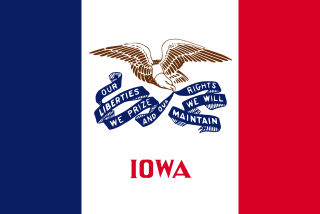
Iowa is a state in the Midwestern United States, bordered by the Mississippi River to the east and the Missouri River and Big Sioux River to the west. It is bordered by six states; Wisconsin to the northeast, Illinois to the east, Missouri to the south, Nebraska to the west, South Dakota to the northwest and Minnesota to the north.

Minnesota is a state in the Upper Midwest, Great Lakes, and northern regions of the United States. Minnesota was admitted as the 32nd U.S. state on May 11, 1858, created from the eastern half of the Minnesota Territory. The state has a large number of lakes, and is known by the slogan the "Land of 10,000 Lakes". Its official motto is L'Étoile du Nord.

Father Jacques Marquette S.J., sometimes known as Père Marquette or James Marquette, was a French Jesuit missionary who founded Michigan's first European settlement, Sault Ste. Marie, and later founded St. Ignace, Michigan. In 1673, Father Marquette and Louis Jolliet were the first Europeans to explore and map the northern portion of the Mississippi River Valley.
The 18th century was devastating for the Missouria people. Smallpox killed many in the tribe, as did constant warfare with enemies, such as the Sac and Fox. In 1796, some surviving Missouria joined the Osage and Kaw tribes, while 80 Missouria joined the Otoe. [2]

Smallpox was an infectious disease caused by one of two virus variants, Variola major and Variola minor. The last naturally occurring case was diagnosed in October 1977 and the World Health Organization (WHO) certified the global eradication of the disease in 1980. The risk of death following contracting the disease was about 30%, with higher rates among babies. Often those who survived had extensive scarring of their skin and some were left blind.

The Osage Nation is a Midwestern Native American tribe of the Great Plains. The tribe developed in the Ohio and Mississippi river valleys around 700 BC along with other groups of its language family. They migrated west of the Mississippi after the 17th century due to wars with Iroquois invading the Ohio Valley from New York and Pennsylvania in a search for new hunting grounds. The nations separated at that time, and the Osage settled near the confluence of the Missouri and the Mississippi rivers.
In the 19th century, the Missouria and the Otoe established permanent villages consisting primarily of earth lodges, but also occasionally tipis and bark lodges. Their joined society was patrilineal and comprised seven to ten clans. Tribal members had to marry outside of their clan. Each clan had a leader, and together the clan chiefs formed a tribal council. The chief of the Bear Clan was the principal leader of the tribes. They hunted buffalo and grew such crops as squash, beans, corn, and pumpkins. [2] In 1803, Lewis and Clark estimated their population to be 500. George Catlin estimated their population at 1200 in 1833. In 1830 there were an estimated 1500 Otoe-Missouria living in together. By 1886, only 334 Otoe-Missouria survived. [3]

A tipi is a cone-shaped tent, traditionally made of animal skins upon wooden poles. Modern tipis usually have a canvas covering. A tipi is distinguished from other conical tents by the smoke flaps at the top of the structure. Historically, the tipi has been used by Indigenous people of the Plains in the Great Plains and Canadian Prairies of North America. They are still in use in these communities, though now primarily for ceremonial purposes rather than daily living. A similar structure, the lavvu is used by the Sámi people of northern Europe.

A wigwam, wickiup or wetu is a semi-permanent domed dwelling formerly used by certain Native American and First Nations tribes, and still used for ceremonial purposes. The term wickiup is generally used to label these kinds of dwellings in the Southwestern United States and Western United States, while wigwam is usually applied to these structures in the Northeastern United States and Canada. Wetu is the Wampanoag term for a wigwam dwelling. These terms can refer to many distinct types of Native American structures regardless of location or cultural group. The wigwam is not to be confused with the Native Plains teepee, which has a very different construction, structure, and use.
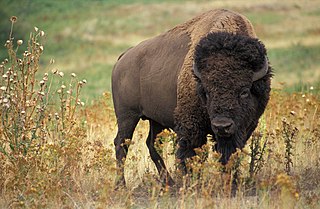
Bison are large, even-toed ungulates in the genus Bison within the subfamily Bovinae.
The first land cession treaty between the Otoe-Missouria and the United States was in 1830. These were followed by more treaties in 1833, 1836, and 1854. The 1854 Treaty established a reservation on the Kansas-Nebraska border, near the Big Blue River. The tribe split in factions of assimilationists and traditionalists. The assimilationist Otoe-Missouria were influenced by Quaker missionaries and became known as the Quaker Band. The traditionalists were known as the Coyote Band. [2]

Kansas is a U.S. state in the Midwestern United States. Its capital is Topeka and its largest city is Wichita, with its most populated county being Johnson County. Kansas is bordered by Nebraska on the north; Missouri on the east; Oklahoma on the south; and Colorado on the west. Kansas is named after the Kansas River, which in turn was named after the Kansa Native Americans who lived along its banks. The tribe's name is often said to mean "people of the (south) wind" although this was probably not the term's original meaning. For thousands of years, what is now Kansas was home to numerous and diverse Native American tribes. Tribes in the eastern part of the state generally lived in villages along the river valleys. Tribes in the western part of the state were semi-nomadic and hunted large herds of bison.

The Big Blue River is the largest tributary of the Kansas River. The river flows for approximately 359 miles (578 km) from central Nebraska into Kansas, until its confluence with the Kansas River at Manhattan.
In 1876 Congress arranged the sale of 120,000 acres (490 km2) of the Otoe-Missouria reservation and sold the rest in 1881, when Congress forced the Otoe-Missouria into Indian Territory. The Coyote Band settled on the Sac and Fox reservation, while the Quaker Band settled on their own small, 113-acre (0.46 km2) reservation in present-day Noble and Pawnee Counties. [2]
The Coyote Band rejoined the Quaker Band, but their reservation was almost immediately broken up into individual allotments, as dictated by the Dawes Act, in the 1890s. A total of 514 Otoe-Missourias received individual allotments. Much later, in the 1960s the Otoe-Missouria people were compensated for their lands lost during the 19th century by the Indian Claims Commission. [2]
The tribe's constitution was ratified in 1984 in accordance with the Oklahoma Indian Welfare Act. [2]
Government
The Otoe-Missouria Tribe of Indians is headquartered in Red Rock, Oklahoma, and their tribal jurisdictional area is in Noble County and Kay County, Oklahoma. There are 3,089 enrolled tribal members with the majority living within the state of Oklahoma.
The Tribal Council is the elected governing body of the Otoe-Missouria Tribe. The primary duties of the Tribal Council are to enforce the Tribal Laws and Policies and to serve as the decision-making authority on budgets and investments. The Tribal Council is also the parent body for the Tribal Administration. Overall, the Tribal Administration ensures that services, as decided by the Tribal Council, are provided to Tribal Members.
The Tribal Council consists of a seven members elected by secret ballot by qualified voters of the Tribe. The terms for each member are staggered and last for three years. There are no term limits. Each Tribal Council member has responsibilities for certain duties as listed in the Otoe-Missouria Tribe of Indians Constitution.
The Council holds regular meetings monthly in a place and date determined by the members. Currently the meetings are held in the Council Building at tribal headquarters. And are open to the public, except when the Council is in Executive Session. [4]
The tribe's Chairman is John R. Shotton, currently serving a three-year term. [1] Shotton has the distinction of being the youngest person to ever serve on the tribal council, being first elected when he was 29 years old. [5]
Economic development
The tribe operates its own housing authority and issues tribal vehicle tags. They own two gas stations, two smoke shops, two financial services companies, and five casinos. The estimated annual economic impact of the Otoe-Missouria Tribe is $79 million. [1] The Otoe-Missouria casinos are 7 Clans Paradise Casino in Red Rock; First Council Casino in Newkirk, and Lil' Bit of Paradise Casino—Chilocco, also in Newkirk; and Lil' Bit of Paradise Casino—Red Rock, in Red Rock. A new casino was opened in May 2016 in Perry, Oklahoma. [6]
In October 2016, through a deal reached with CEO Mark E. Curry, the Tribe acquired technology vendor MacFarlane Group. MacFarlane Group previously assisted the Tribe with underwriting and call center support for American Web Loan, one of the Tribe's financial services companies. [7] The Tribe still receives technology support from Think Finance for its other financial services business, Great Plains Lending. [8]

The Kickapoo People are an Algonquian-speaking Native American and Indigenous Mexican tribe. Anishinaabeg say the name "Kickapoo" means "Stands here and there," which may have referred to the tribe's migratory patterns. The name can also mean "wanderer". This interpretation is contested and generally believed to be a folk etymology.

As general terms, Indian Territory, the Indian Territories, or Indian country describe an evolving land area set aside by the United States Government for the relocation of Native Americans who held aboriginal title to their land. In general, the tribes ceded land they occupied in exchange for land grants in 1803. The concept of an Indian Territory was an outcome of the 18th- and 19th-century policy of Indian removal. After the Civil War (1861–1865), the policy of the government was one of assimilation.
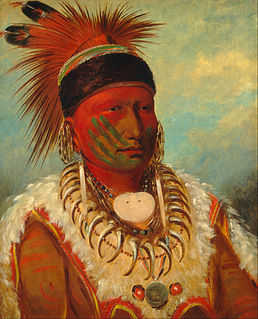
The Iowa or Ioway, known as the Báxoǰe in their own language, are a Native American Siouan people. Today, they are enrolled in either of two federally recognized tribes, the Iowa Tribe of Oklahoma and the Iowa Tribe of Kansas and Nebraska.

The Otoe are a Native American people of the Midwestern United States. The Otoe language, Chiwere, is part of the Siouan family and closely related to that of the related Iowa and Missouri tribes.
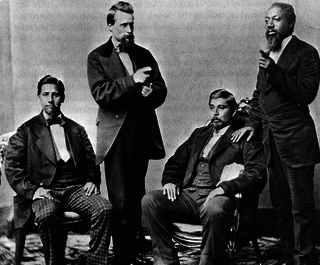
Blood quantum laws or Indian blood laws are those enacted in the United States and the former Thirteen colonies to define qualification by ancestry as Native American, sometimes in relation to tribal membership. These laws were developed by European Americans and thus did not necessarily reflect how Native Americans had traditionally identified themselves or members of their in-group, and thus ignored the Native American practices of absorbing other peoples by adoption, beginning with other Native Americans, and extending to children and young adults of European and African ancestry. Blood quantum laws also ignored tribal cultural continuity after tribes had absorbed such adoptees and multiracial children. Tribal enrollments were often incomplete or inaccurate for multiple reasons; individuals didn't trust the government and so they refused to enroll, families relocated before censuses were taken, or individuals were incorrectly identified by white men, whom were the census takers.

The Iowa Tribe of Oklahoma is one of two Federally recognized tribes for the Iowa people. The other is the Iowa Tribe of Kansas and Nebraska. Traditionally Iowas spoke the Chiwere language, part of the Souian language family. Their own name for their tribe is Bahkhoje, meaning, "grey snow," a term inspired by the tribe's traditional winter lodges covered with snow, stained grey from hearth fires.
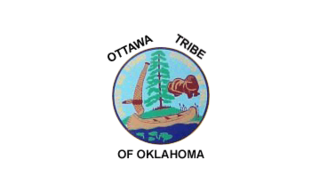
The Ottawa Tribe of Oklahoma is one of four federally-recognized Native American tribes of Odawa people in the United States. Its ancestors had migrated into Michigan and Ohio in the 18th century. In the late 1830s they were removed to west of the Mississippi River, first to Iowa, then to Kansas in what was then Indian Territory. In 1867 they sold their land to purchase territory in what became Oklahoma, then primarily settled by Native Americans.

The Absentee Shawnee Tribe of Indians of Oklahoma is one of three federally recognized tribes of Shawnee people. Historically residing in the Eastern United States, the original Shawnee lived in the areas that are now Ohio, Indiana, Illinois, Kentucky, Tennessee, Pennsylvania, and other neighboring states. It is documented that they occupied and traveled through lands from Canada to Florida, from the Mississippi River to the eastern continental coast. In contemporary times, the Absentee Shawnee Tribe headquarters is in Shawnee, Oklahoma; its tribal jurisdiction area includes land properties in Oklahoma in both Cleveland County and Pottawatomie County.
Truman Washington Dailey,
also known as Mashi Manyi and Sunge Hka, was the last native speaker of the Otoe-Missouria dialect of Chiwere (Baxoje-Jiwere-Nyut'chi), a Native American language. He was a member of the Otoe-Missouria Tribe of Indians.

The Winnebago Tribe of Nebraska is one of two federally recognized tribes of Ho-Chunk Native Americans. The other Ho-Chunk tribe is the Ho-Chunk Nation of Wisconsin. The name Winnebago comes from an Algonquian term "People of the Filthy Water." Tribe members often refer to themselves as Hochungra - "People of the Parent Speech".

The Augustine Band of Cahuilla Indians is a federally recognized Cahuilla band of Native Americans based in Coachella, California. They are one of the smallest tribal nation in the United States, consisting of only eight members, only one of whom is an adult. As of the 2010 census, the tribe had expanded its members to eleven.

Native American tribes in the U.S. state of Nebraska have been Plains Indians, descendants of succeeding cultures of indigenous peoples who have occupied the area for thousands of years. More than 15 historic tribes have been identified as having lived in, hunted in, or otherwise occupied territory within the current state boundaries.

Several Native American tribes within the United States register motor vehicles and issue license plates to those vehicles.
The Otoe Reservation was a twenty-four square-mile section straddling the Kansas-Nebraska state line. The majority of the reservation sat in modern-day southeast Jefferson County, Nebraska.

The Iowa Reservation of the Iowa Tribe of Kansas and Nebraska straddles the borders of southeast Richardson County in southeastern Nebraska and Brown and Doniphan Counties in northeastern Kansas. Tribal headquarters are west of White Cloud, Kansas. The reservation was defined in a treaty from March 1861. Today the tribe operates Casino White Cloud on the reservation.
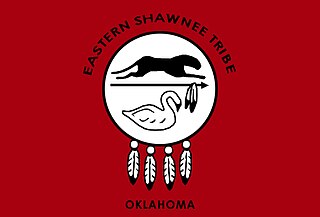
The Eastern Shawnee Tribe of Oklahoma is one of three federally recognized Shawnee tribes. They are located in Oklahoma and Missouri.
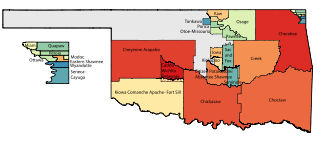
Oklahoma Tribal Statistical Area is a statistical entity identified and delineated by federally recognized American Indian tribes in Oklahoma as part of the U.S. Census Bureau's 2010 Census and ongoing American Community Survey. Some of these areas are also formally recognized as reservations, while the reservation status of others is less certain. Many of these areas are also designated Tribal Jurisdictional Areas, areas within which tribes will provide government services and assert other forms of government authority.































